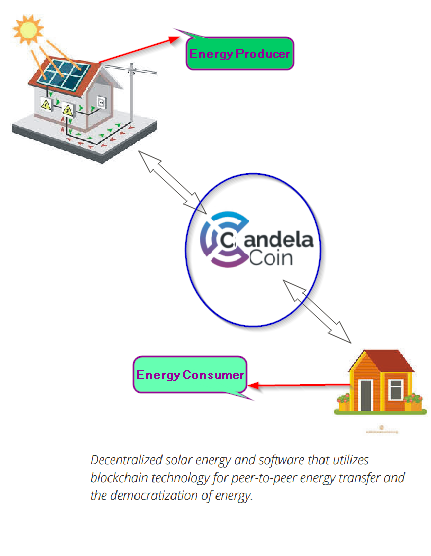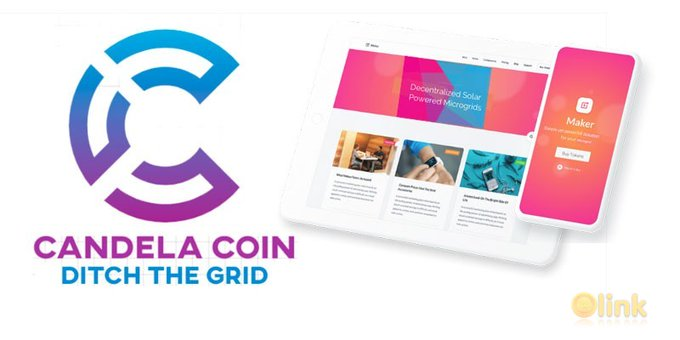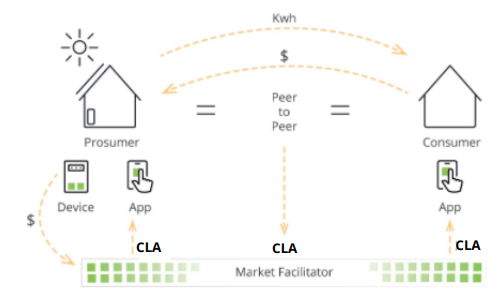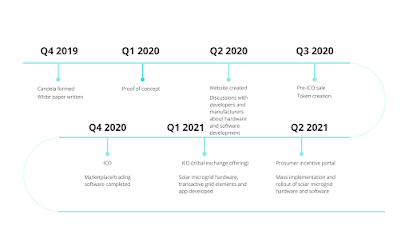INTRODUCTION
All across the world the new energy consumer wants comfort, security, a more engaging relationship, and a promising future for energy production. A democratized energy marketplace is the only way to achieve this promise, and the Candela Coin team has developed a key piece of this paradigm shift. With Candela Coin, we are reimagining the customer’s role in, and access to, increasingly open and competitive solar electricity markets. The energy market is currently facing challenges with its centralized conventional power stations and grid that require high costs to maintain. This means higher costs for the consumer. The existing electricity and power model will not be able to keep up with the increasing electricity demand with its centralized grid and infrastructure. Costs will rise dramatically. Consumption is expected to more than double by 2050. A paradigm shift is necessary. A shift to decentralized solar powered microgrids made up of people is what we are building. We want communities to create their own decentralized solar energy.
Blockchain technology can benefit and accelerate the shift to solar energy. It fits perfectly into the renewable energy sector because it allows direct peer-to-peer transactions between users, and offers transparency and local energy self-sustainability. This project aims to create truly decentralized solar energy across the globe made up of we the people, instead of the power companies or middlemen. This will allow peer to peer production and transfer of solar energy. Utilizing blockchain technology allows us to create seamless production and peer to peer transfer of solar energy. We share many things with those in our community. There is constant exchange and interaction with those around us. The one thing we haven’t been able to share is the very thing needed to make any of it happen: Energy
This will reduce disruptions caused by incidents hundreds of miles away such as hurricanes and leave you unaffected. While the rest of the city may lose power, your family and community will be okay. Energy decentralization and democratization has come. Embrace it. In this paper, we link the technical value domains to the services that consumers, prosumers and third parties can provide to one another and to the electric power system

What is the Candela project?
Our vision is to create truly decentralized solar energy all across the world made up of we the people, not the power companies or middlemen. We have created IoT hardware and software for seamless peer-to-peer energy transfer. By using blockchain technology we enable owners of solar panels to sell their generated energy to other users, bringing in the best returns possible for their solar energy and the cheapest green energy on the market. People across the globe will be able to transfer solar energy to others in their communities using Candela coin as a medium of exchange. Our decentralized system does not rely on the existing power grid infrastructure. In the event of inclement weather, power outages, or down power lines, decentralized solar power will still be able to be generated and provide electricity to the community. Candela is the impetus for the democratization of energy.

THE PROBLEM
The energy market is currently facing challenges with its centralized conventional power stations and grid that require high costs to maintain. This means higher costs for the consumer. The existing electricity and power model will not be able to keep up with the increasing electricity demand with its centralized grid infrastructure. Costs will rise dramatically. Consumption is expected to more than double by 2050. Many problems we face also include power company monopolies and duopolies, poor service or non functional service during times of crisis, inclement weather, or in developing areas. There are also the issues that stem from government regulations. With the power companies if you don’t pay for monthly service your power is shut off. With candela you use what you buy. It’s like going to the grocery store. Get power without a power company.
If a prosumer wants to sell their excess solar energy back to the grid, they are given cents on the dollar. Our solution woud allow them to get more money for their excess solar energy as well as reduce the costs for the consumer. Our economies run on energy, but the current energy system is costly and inefficient. Creating useful energy is one of the dirtiest and most wasteful things we do, from mining, refining and burning fuel, to transporting electricity across long transmission and distribution lines. In the US, some estimates show an 86 percent inefficiency in converting and transporting energy into the useful product that powers modern lifestyles and economic productivity.
This creates unintended and costly health and environmental challenges, from asthma to climate change, and a significant loss of economic value. It turns out that the U.S. economy is not especially energy efficient. Of the total high-quaity energy consumed to support economic activity in 2010, only 14 percent was converted into useful work. In other words, the American economy wasted 86 percent of all the energy used that year in the production of goods and services. One can easily imagine that waste of this magnitude creates an array of costs that weakens the nation’s economic and social well-being.
This problem has emerged because in the current power sector business models, utilities use outdated constructs of its consumers as rate payers; missing the opportunity and value only a customer can provide. Companies earn revenue based on producing energy at the center of the utility grid, in large power plants, and pushing it to the grid edge where it “serves the load” as it is consumed. Companies generating and distributing power are accustomed to roughly 10 percent returns on their capital investment. This model locks in profitability for regulated electricity companies, but discourages innovation and saddles consumers with decades of legacy costs.
In newly-electrifying countries, a centralized grid is too costly and sluggish for the needs of the one billion people without energy access today. As demand grows, it also becomes more distributed. It is harder and more costly to predict and balance supply and demand while lacking visibility into millions of new consumer devices and distributed energy resources popping up at the grid edge. These trends are tearing apart existing utility business models and spooking shareholders and analysts alike.

THE SOLUTION
Get power without a power company. We propose that the answer to these mounting concerns is Candela, a blockchain based system that functions across connected hardware (IoT devices), a token system for transactive energy (Candela Coin), and a foundation that advances market design and technology in tandem.
We want communities across the world to create their own decentralized solar energy. Individuals in the community will own their solar panels and can sell their excess energy to others in the community. We envision that people with solar panels, small and large, will all be able to contribute electricity to the Candela system. If a user wants to sell their solar energy back to the grid, they are given cents on the dollar. Our solution would allow them to get more money for their solar energy as well as reduce the costs for the purchaser.
Candela uses an IoT metering device that runs blockchain technology, giving it capabilities not currently available in many energy markets. First, it shows solar panel owners how much energy they’re producing, rather than having them trust the local utility to calculate the amount. The blockchain also enables the direct transfer of energy between users and dramatically reduces the costs of such transactions. The community marketplace solution offers a compelling way for users in a community to buy and sell solar energy. Users can easily make an offer, create a budget, or even sell their own power on the marketplace.
Candela can manage the flow of electricity and the exchange of energy within electric power systems through the formation and delivery of pricing signals, use of predictive analytics and automation of activities, which reflect true cost of local service. This can all happen behind the scenes, at the machine-to-machine level. The system unlocks value to be assembled in new ways and priced appropriately. Transactive energy, properly implemented, represents the fairest allocation of risk and reward enabling new business models that provide services to participants.
By rewarding efficiency and flexibility, the system has the potential to activate value for customers and create new ways to manage and invest in the responsive grid of the future, which is beneficial in developed economies, and it can be transformative in newly electrifying ones. Candela can provide a wide range of benefits throughout the electricity market and ecosystem. In addition to clear value for market participants (described in detail further below),
Key outcomes include:
1. Efficient and adaptive market pricing
2. Improved system reliability and flexibility
3. Pathway for technological innovation
4. Improved balance of risk and reward for asset owners
5. A rich, interactive future for an energy industry serving informed communities
Candela Peer-To-Peer Trading And Marketplace Software
Candela marketplace enables prosumers and consumers to a unique energy marketplace so all members of thecommunity can trade energy in order to achieve both personal and community energy goals. This is a marketplace designed to directly connect prosumers and consumers to their community.
Powerful Metrics
Analyze the market with customer and trade analytics, trading dynamics, offer subscriptions, and other configurable analytics from consumers and prosumers in an easy-to-use portal.

PRODUCT
Candela creates the ability to buy and sell solar energy between users. We use the ethereum blockchain to secure and manage the data needed to create marketplace transactions. The Candela Coin provides the incentive for energy prosumers and consumers to contribute and participate in an energy marketplace. Candela is based on a market model called transactive energy, which refers to economic and control techniques that enable broad participation in the new multi-party energy system, and designed to provide all market participants more opportunities to connect.
MARKETPLACE/TRADING SOFTWARE
Candela marketplace enables prosumers, consumers, and commercial producers to introduce a unique energy marketplace so all members of the community can trade energy in order to achieve both personal and community energy goals. This is a marketplace designed to directly connect prosumers, commercial producers and consumers to their community.
1. Flexible Trading:
Configure your marketplace to trade energy and enable your consumers to source renewables from their local community.
2. Powerful Metrics:
Analyze the market with customer and trade analytics, trading dynamics, offer subscriptions, and other configurable analytics from prosumers and consumers in an easy-to-use portal.
3. Personal Energy Management:
Lead prosumers and consumers on a new energy journey, starting with valuable energy tools on a branded mobile application, to learn about their energy profile and renewable engagement opportunities.
4. Highly Extensible:
Securely integrate to third-party software and energy devices to power your marketplace and streamline your customer’s experience. Simple
5. Deployment:
Launch a marketplace in 90 days with a team of experts who partner with you through every implementation stage from design collaboration, to test and turn up, and ongoing support.
6. Secure and Scalable:
Purpose built using Blockchain technology to ensure personal and system data security from day one and as trading transactions scale.
USE CASES
Use Case 1:
Peer-to-Peer Energy
Electricity retailers and distribution utilities generate revenue by selling electricity to customers and ensuring a reliable power supply. Last year, Europe’s 260 million electricity customers paid more than €115 billion for their electricity. Across the US, EU and Australia, customers paid $185 billion. As DERs continue to proliferate, so too will the ability to transact locally with other network participants. As the Candela network grows, we envision that an increasing amount of this power will be sold not between utilities and customers, but between customers themselves, peer-to-peer, on the Candela platform.

Step 1:
John is a ‘prosumer’ with solar panels on his roof. He buys a Candela compliant metering device.
Step 2:
John downloads the mobile app that lets him join his local community solar energy exchange. The app is enabled by his own CLA token, or by one provided for that purpose byan interested third party.
Step 3:
John uses CLA tokens and his metering device to join the local marketplace.
Step 4:
John earns CLA tokens for selling his power to his neighbors on the local market.
Step 5:
His neighbor also downloads the app because she wants to buy power from John. She sets her budget for local renewable energy in the app and pays with CLA tokens.
Use Case 2:
Decentralized Solar Energy Matrix
We plan to help communities across the world develop their own decentralized solar energy matrices. This will allow peer to peer energy trading between prosumers and consumers in the community. Matrices today encompass a range of integrated grid-edge hardware and software technologies to operationalize closed, efficient, clean-energy systems ranging in size from a hospital or campus to a military installation or entire island nation. These resilient systems can be tied to existing grid infrastructure or deployed as a standalone entity—vital to the effort to bring electricity to the 1.2 billion people still without power around the world. The market is set to nearly double in value to $23 billion by 2021. Solar energy matrices represent the decentralized infrastructure model of the future, and Candela can be the enabling functionality to accelerate deployment around the world. Solar energy matrix project developers, operators and other hardware vendors all see additional value by earning and holding CLA tokens. Candela can improve system-wide operational efficiency by responsive load management, thus improving return on investment (ROI) and economics for developers and operators. It will allow monitoring of excess capacity and potential to sell to other consumers in other matrices as long as they are connected, or otherwise find value for the storage and other services available from your matrix. Data transparency and uniformity across project portfolios will further support the ecosystem.
Use Case 3:
Connectivity Event
Our role is evolving as more activity is required to ensure real and reactive power requirements are met in a world of distributed energy resources. At some point there could be the possibility of a connectivity event. All the matrices could transfer electricity/energy between each other. According to the International Energy Agency, smart demand response alone could save $270 billion globally in investment in new energy infrastructure that would otherwise have been required by 2040. Already the Demand Response Auction Mechanism in California is showing that up to $27 million may be spent annually to deliver demand shaving. The data is worth more or less depending on the location and timing
Use Case 4:
Electric Vehicle smart charging
Electric vehicle adoption is accelerating rapidly. In 2016 the total number of electric vehicles topped 1 million for the first time; today there are already more than 2 million. By 2025, 40 to 70 million are forecasted. At ~3 MWh of power consumption per year per vehicle, these new cars will consume the output of one hundred new 400 MW combined cycle natural gas power plants every year. Where, when, and how drivers charge their EVs will be an increasingly important challenge—and opportunity—for managing the grid. Today, in the US alone, that market is $250 million. Globally, by 2025, it will reach $25 billion.
TOKEN ECONOMICS
Candela will use the ethereum blockchain to establish and manage a global network of energy market among participants. This also will establish location, security and proof of ownership. The Candela coin (CLA token) is an ERC20-compliant medium of exchange and will be used to attract consumers, producers and communities to the marketplace by requiring and incentivizing them to acquire and hold tokens. Producers and consumers will be rewarded for participating in local energy markets.
Other market participants such as generators, aggregators and service providers can also acquire and hold tokens. Commercial agents can acquire and hold tokens both for themselves and on behalf of (and with the consent of) consumers and producers as they see value in the data transfer at the edge of the grid that they would not have access to without significant investment. CLA tokens will be redeemable for hardware and Candela IoT devices. They will also be used by consumers to purchase energy from producers and possible commercial energy suppliers as well.
Producers will be compensated on a monthly basis just for producing solar electricity. They will be compensated in CLA tokens based on the amount of solar electricity they produce each month. We want to do our part to ensure a clean, green future. A fixed global supply of CLA will be minted, once, upon the Candela Coin launch event. CLA will be used to access and use mobile accounts and Candela-compliant hardware devices of market participants to enable them to participate in the network. CLA tokens will not be mined.
Token info
Ticker: CLA
Platform: Ethereum
Token Type: ERC-20
Available for sale: 95,000,000 CLA (76%)
Total supply: 125,000,000 CLA
Token Distribution
INVESTORS 76%
TEAM 20%
REWARDS 4%
Roadmap

Team

CONCLUSION
With blockchain technology becoming ubiquitous, we see its integration into the energy sector as the logical next step. Candela coins are a digital currency and a medium of exchange in solar energy transactions in decentralized solar energy matrices. We will decentralize the energy industry. Decentralized solar power in communities across the globe will lead to to lower costs, higher compensation for solar energy prosumers, a reward for solar energy producers, and accelerate the global clean energy transition. Global aspirations of societies today are to create energy resiliency, security, access, decarbonization and democratization at the lowest cost
To get clearer information, please visit the link below:
Website: https://www.candelacoin.com/
Telegram: https://t.me/candelacoindiscussion
Twitter: https://twitter.com/candelacoin
Facebook: https://www.facebook.com/Candela-Coin-111118247315246/
LinkedIn: https://www.linkedin.com/company/candela-foundation/
Reddit: https://www.reddit.com/r/CandelaCoin/
Instagram: https://www.instagram.com/candelacoin/
Youtube: https://www.youtube.com/channel/UCE4g5uz2tLyKe5xolPQzMNg
WHITEPAPER: https://uploads-ssl.webflow.com/5ee80918fa53c4dbf6968b3c/5f111ea74156e3098fb6874d_white%20paper%20(11).pdf
Other links (may be needed)
ICO Evaluators: https://icomarks.com/ieo/candela
AUTHOR
Bitcointalk Username: Dewi08
Telegram Username: @ dhewio8
Bitcointalk url: https://bitcointalk.org/index.php?action=profile;u=894088
Wallet address (eth): 0x53D1Ea8619E638e286f914987D107d570fDD686B